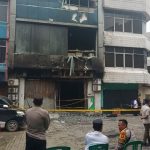Liga Asuransi – Hello risk takers, how are you? I hope your business is doing well.
Let’s continue the discussion about risk management and insurance. This time, we will explore the risks of trade expos, music shows, or conferences.
If you are interested in this article, please share it with your friends so they can understand as you do.
In today’s dynamic business and entertainment landscape, events, conferences, music shows, trade expos, and similar gatherings have evolved beyond social groups and entertainment platforms. They have become pivotal components driving various industries forward. Here’s a closer look at the growing significance of these events:
Networking and Collaboration Opportunities:
Events provide a unique opportunity for professionals, entrepreneurs, and stakeholders to network, connect, and collaborate.
Conferences and trade expos bring together industry experts, thought leaders, and innovators to share insights, trends, and knowledge.
Knowledge Sharing and Skill Development:
Conferences and seminars offer a platform for learning from experts and gaining new perspectives on industry trends and best practices.
Workshops and training sessions within events facilitate skill development and foster personal growth.
Market Exposure and Brand Visibility:
Trade expos and exhibitions allow businesses to showcase products and services to a diverse and engaged audience.
Music shows and entertainment events allow artists and performers to reach wider audiences and build their brand.
Innovation and Product Launches:
Events serve as launchpads for new products, technologies, and services, generating buzz and anticipation within the industry.
Tech expos and innovation summits provide a platform for showcasing groundbreaking advancements.
Cultural Enrichment and Entertainment:
Music shows, cultural festivals, and art exhibitions enrich society by promoting creativity and cultural diversity.
Entertainment events provide audiences with memorable experiences and emotional connections.
Economic Impact and Revenue Generation:
Events stimulate local economies by attracting attendees who spend on accommodations, dining, transportation, and more.
Trade expos foster business deals and transactions, contributing to economic growth.
Knowledge Transfer and Thought Leadership:
Conferences and panel discussions facilitate the exchange of ideas, trends, and research findings, fostering thought leadership.
Industry-specific events provide a platform for sharing best practices and innovative solutions.
Community Engagement and Social Interaction:
Events strengthen communities by bringing people together around shared interests- art, business, technology, or entertainment.
Music shows and cultural events create a sense of unity and belonging among attendees.
Promotion of Sustainable Practices:
Events offer a platform for promoting eco-friendly and sustainable practices, encouraging attendees and organizers to adopt responsible behaviors.
Technology and Digital Engagement:
Hybrid and virtual events have gained prominence, allowing global participation and leveraging technology for broader reach.
Digital platforms enable real-time interactions, expanding the potential audience base.
RISKS AND VULNERABILITIES IN EVENTS
Crowds and Safety Concerns:
Events that draw large crowds create exciting opportunities for engagement, networking, and entertainment. However, they also come with a set of inherent risks that event organizers must navigate to ensure the safety and well-being of attendees. From the bustling trade expo floor to the energized music concert arena, understanding and addressing these risks is essential. Among the primary concerns are accidents, slips, falls, and other mishaps that can occur when managing sizable audiences.
Crowd Dynamics and Movement:
Large crowds can create chaotic situations, making it challenging to control the movement and flow of people.
Dense crowds might lead to pushing, shoving, or stampedes if not properly managed, potentially causing injuries.
Trips and Slips:
With numerous attendees navigating through event spaces, the risk of trips and slips over uneven surfaces, cables, or obstacles increases.
Weather conditions, such as rain or snow, can exacerbate slip hazards.
Uneven Ground and Structural Hazards:
Outdoor events or venues with temporary setups might have uneven ground, ramps, or platforms that pose tripping hazards.
Structural elements like scaffolding, stages, or temporary seating must be properly secured to prevent accidents.
Obstructed Views and Falls:
In concerts and shows, attendees may climb on structures or attempt to reach better vantage points, risking falls.
Poorly designed seating arrangements can lead to obstructed views, prompting attendees to find alternative, potentially unsafe spots.
Emergency Evacuations:
Large crowds make swift and organized evacuations during emergencies, such as fires or natural disasters, more challenging.
Panic or confusion might lead to injuries or stampedes if evacuation plans are not in place.
Medical Emergencies:
The presence of many people increases the likelihood of medical emergencies, requiring immediate attention and access to medical personnel.
Security Concerns:
Crowded events can attract individuals with malicious intent, necessitating robust security measures to prevent incidents.
Vendor and Equipment Risks:
If not secured properly, vendors’ equipment and setups can pose risks of collapsing or causing accidents.
Electrical setups and wiring for sound systems or lighting can become tripping hazards.
Addressing Safety Concerns:
Risk Assessment: Conduct a comprehensive risk assessment identifying potential hazards and vulnerabilities specific to the event’s venue and nature.
Crowd Management:
To guide attendees safely, implement crowd control measures, such as designated pathways, barriers, and clear signage.
Infrastructure and Setup:
Ensure all temporary structures are constructed to code and seating arrangements provide clear pathways and unobstructed views.
Emergency Plans:
Develop and communicate clear emergency evacuation plans, and conduct drills to prepare staff and attendees for different scenarios.
Medical Support:
Have trained medical personnel on-site to provide immediate assistance, first aid stations, and medical kits.
Security Measures:
Employ trained security personnel and implement measures like bag checks and surveillance to prevent security breaches.
Communication:
Keep attendees informed about safety protocols and emergency procedures through announcements, signage, and digital platforms.
Insurance Coverage:
Public Liability Insurance (PLI) can provide financial protection in case of accidents, injuries, or property damage during the event.
By proactively addressing these safety concerns and implementing measures to mitigate risks, event organizers can create a secure and enjoyable environment for attendees, ensuring that the focus remains on the event’s purpose and success.
PROPERTY DAMAGE RISKS IN EVENTS
Events inherently pose property risks with their intricate setups, bustling activities, and diverse attendees. Whether during the setup phase, the event itself, or teardown, many factors can contribute to property damage. From equipment malfunctions to unexpected disasters, event organizers must anticipate and mitigate these risks to ensure a smooth and secure experience for all involved.
Setup and Teardown Hazards:
During the installation and dismantling of event setups, there’s a risk of accidental damage to structures, equipment, and surroundings.
Mishandling heavy equipment, improper installation of displays, or collisions can result in property damage.
Equipment Malfunction:
Audiovisual equipment, lighting systems, and other technical components are susceptible to malfunctioning, which can cause damage to the equipment itself or other nearby items.
Electrical Issues:
Improper wiring or overloading electrical circuits can lead to electrical fires, damaging equipment structures and causing potential safety hazards.
Fire Hazards:
Events often involve numerous electrical connections, lighting setups, and flammable materials, increasing the risk of fire incidents.
A small fire can quickly escalate and cause extensive property damage.
Natural Disasters:
Outside events are vulnerable to adverse weather conditions such as rain, wind, hail, and storms, which can damage structures and equipment.
Earthquakes, floods, and other natural disasters can have a catastrophic impact on event venues and setups.
Vandalism and Sabotage:
Large gatherings can attract unwanted attention, potentially leading to vandalism or intentional damage to property and equipment.
Structural Failures:
Temporary structures, stages, and seating can collapse due to poor construction, inadequate support, or unexpected factors like sudden wind gusts.
Accidental Spills and Damage:
Events involving food and beverages carry the risk of spills and stains that can damage flooring, furniture, and equipment.
Mitigating Property Damage:
Thorough Inspections: Conduct meticulous inspections before and during the event to identify any structural or equipment issues that could lead to damage.
Quality Equipment:
Invest in reliable, well-maintained equipment to minimize the chances of malfunctions during the event.
Proper Wiring and Electrical Safety:
Ensure all electrical installations comply with safety standards and avoid overloading circuits.
Fire Safety Measures: Implement fire prevention measures, such as using flame-retardant materials, having fire extinguishers on hand, and creating evacuation plans.
Weather Preparedness:
Monitor weather forecasts and have contingency plans for adverse weather conditions.
Security:
Deploy adequate security personnel to deter vandalism and safeguard equipment and property.
Vendor Agreements:
Clearly define responsibilities and liabilities in vendor contracts to address potential property damage caused by third parties.
Insurance Coverage:
Public Liability Insurance (PLI) can also cover property damage, providing financial protection against unforeseen losses.
By acknowledging and addressing the risks of property damage, event organizers can better protect their investments, reputation, and the safety of all involved. A proactive approach to risk management helps ensure that the event is successful and leaves a positive and lasting impression.
PUBLIC LIABILITY INSURANCE (PLI) SAFEGUARDING EVENTS AND EXPOS
Public Liability Insurance (PLI) is a vital component of risk management that offers financial protection to event organizers, exhibitors, and attendees against potential legal liabilities arising from bodily injuries or property damage suffered by third parties during an event or expo. It provides coverage for legal expenses, medical costs, and compensation claims that could result from accidents, mishaps, or unforeseen incidents.
In the context of events and expos, PLI holds immense relevance due to these gatherings’ dynamic and often unpredictable nature. The potential for accidents and property damage is heightened with large crowds, intricate setups, and various activities. PLI seeks to alleviate the financial burdens that could arise from legal claims, allowing organizers and participants to focus on the event’s success rather than worrying about potential financial setbacks.
Public Liability Insurance (PLI) coverages:
- Accident Coverage: PLI covers medical and legal expenses if attendees or third parties sustain injuries during the event. This coverage helps manage potential medical claims and legal actions.
- Property Damage Coverage: PLI provides reimbursement for property damage caused to the event venue, third-party properties, or equipment. This protects against financial liabilities stemming from accidental property damage.
- Legal Defense: PLI offers financial support for legal defense, including attorney fees and court expenses, in case of lawsuits or legal claims arising from accidents. It assists in investigating allegations and establishing liability, if necessary.
- Risk Management: With PLI, event organizers can demonstrate their commitment to safety and risk management. This can enhance the event’s reputation and credibility.
- Vendor and Exhibitor Protection: Exhibitors and vendors at trade expos are also exposed to potential liability risks. PLI covers them against claims arising from their products, displays, or actions during the event.
- Compliance and Requirements: Many event venues and local regulations require organizers to have PLI coverage before granting permission to
SAMPLES OF ACCIDENTS
Please note that these instances serve as examples of potential risks and the importance of safety measures and insurance coverage:
- The Station Nightclub Fire (2003):
Location: West Warwick, Rhode Island, USA
Event Type: Live music performance
Incident: A fire broke out due to pyrotechnics used during a performance at The Station nightclub. The fire spread rapidly, resulting in 100 fatalities and numerous injuries.
- Indiana State Fair Stage Collapse (2011):
Location: Indianapolis, Indiana, USA
Event Type: Outdoor concert
Incident: High winds caused the stage rigging to collapse onto the audience just before a Sugarland concert. Seven people died, and many were injured.
- Hillsborough Stadium Disaster (1989):
Location: Sheffield, England
Event Type: Soccer match
Incident: Overcrowding and poor crowd control led to a crush of fans at Hillsborough Stadium. In one of the worst stadium disasters in history, 96 people were killed, and hundreds were injured.
- Cologne New Year’s Eve Sexual Assaults (2015):
Location: Cologne, Germany
Event Type: New Year’s Eve celebration
Incident: Sexual assaults and thefts were reported during the New Year’s Eve celebrations in Cologne, sparking a debate about event security and crowd safety.
- MGM Grand Hotel Fire (1980):
Location: Las Vegas, Nevada, USA
Event Type: Casino and hotel complex
Incident: A fire at the MGM Grand Hotel resulted in 85 fatalities and numerous injuries. An electrical fault caused the blaze.
- Love Parade Stampede (2010):
Location: Duisburg, Germany
Event Type: Love Parade electronic music festival
Incident: A stampede occurred in a tunnel leading to the festival grounds, leading to the death of 21 people and injuries to many others.
- Boston Marathon Bombing (2013):
Location: Boston, Massachusetts, USA
Event Type: Marathon race
Incident: Two homemade bombs exploded near the finish line of the Boston Marathon, resulting in three deaths and numerous injuries.
These incidents underscore the need for comprehensive safety planning, risk assessment, crowd management, and Public Liability Insurance (PLI) coverage for event organizers. PLI can help mitigate the financial repercussions of accidents and unforeseen incidents, ensuring those affected receive the necessary support and compensation.
WHY DO YOU NEED AN INSURANCE BROKER FOR PUBLIC LIABILITY INSURANCE?
People often seek the services of an insurance broker for Public Liability Insurance (PLI) when organizing expos, music shows, and similar events for several crucial reasons:
Expertise in Insurance Market:
Insurance brokers have in-depth knowledge of the insurance market, including the various policies, coverage options, and insurance providers available.
They can assess an event’s specific needs and recommend appropriate PLI coverage tailored to the size, nature, and risks associated with the event.
Customized Coverage:
Insurance brokers work closely with event organizers to understand their unique requirements and liabilities.
They help identify potential risks and liabilities specific to the event and then design a customized PLI policy that adequately addresses those risks.
Access to Multiple Insurance Providers:
Brokers typically have access to a vast network of insurance providers, including well-known carriers and specialized niche insurers.
This access allows event organizers to compare multiple PLI options, ensuring they get the most competitive rates and comprehensive coverage.
Cost Savings:
Insurance brokers can negotiate with insurers on behalf of their clients to secure competitive premiums and favorable terms.
By leveraging their industry knowledge and relationships, brokers often help event organizers find cost-effective PLI solutions.
Time and Effort Savings:
Shopping for insurance can be time-consuming and complex, particularly for those unfamiliar with insurance terminology and policies.
Insurance brokers streamline the process by handling paperwork, contacting insurers, and managing administrative tasks, saving event organizers valuable time and effort.
Risk Assessment and Management:
Brokers are skilled in risk assessment and management. They can conduct thorough risk assessments for an event, identifying potential vulnerabilities and suggesting mitigation strategies.
This proactive approach helps prevent accidents and minimize liabilities.
Claims Handling Assistance:
Insurance brokers advocate for their clients in the event of a claim. They facilitate the claims process, ensuring that it proceeds smoothly and efficiently.
Brokers help their clients navigate complex claims procedures and work to secure fair and timely settlements.
Continued Support and Advice:
Insurance brokers provide ongoing support to event organizers throughout the policy period.
They offer advice on risk management practices, policy updates, and adjustments as the event’s circumstances change.
Peace of Mind:
By utilizing an insurance broker’s services, event organizers gain peace of mind, knowing that they have expert guidance and comprehensive PLI coverage to protect their interests and the well-being of event attendees.
Insurance brokers are crucial in helping event organizers secure suitable Public Liability Insurance for expos, music shows, and other events. Their expertise, industry knowledge, access to multiple insurers, and commitment to tailored solutions ensure that event organizers have the right coverage to protect against potential liabilities and financial losses.
One of the leading insurance brokers focusing on Public Liability in Indonesia is L&G Insurance Broker.
For your insurance needs in Indonesia, call L&G Insurance Broker now!
—
LOOKING FOR INSURANCE PRODUCTS? DON’T WASTE YOUR TIME AND CONTACT US RIGHT NOW
L&G HOTLINE 24 HOURS: 0811-8507-773 (CALL – WHATSAPP – SMS)
website: lngrisk.co.id
E-mail: customer.support@lngrisk.co.id
—















